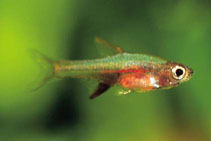| Family: |
Sundadanionidae (Tiny danios) |
| Max. size: |
2.25 cm SL (male/unsexed) |
| Environment: |
benthopelagic; freshwater |
| Distribution: |
Asia: Borneo, Bangka and Sumatra. |
| Diagnosis: |
Dorsal soft rays (total): 9-9; Anal soft rays: 9-9; Vertebrae: 34-35. Semicircular indentation present on the ventromedian flange of the dentary. Branched anal rays 5. Weberian apparatus with the 4th centrum extending well below the fused 2nd + 3rd centra. Sexual dichromatism conspicuous; melanophores in males are a little stronger, and the erythrophores and iridophores are much more developed. When disturbed, repeated croaking sounds are produced. No lateral line pores nor barbels (Ref. 38434). |
| Biology: |
|
| IUCN Red List Status: |
Vulnerable (VU); Date assessed: 04 January 2019 (B1ab(i,ii,iii)+2ab(i,ii,iii)) Ref. (130435)
|
| Threat to humans: |
harmless |
Source and more info: www.fishbase.org. For personal, classroom, and other internal use only. Not for publication.

